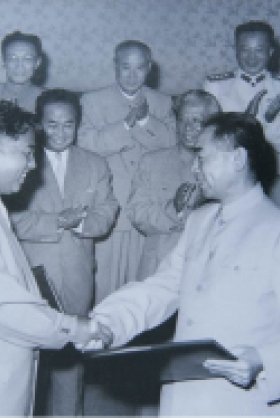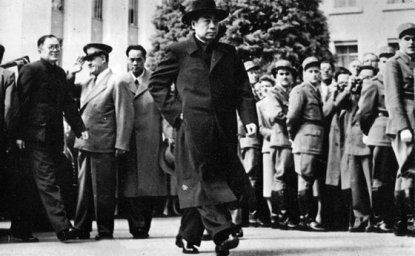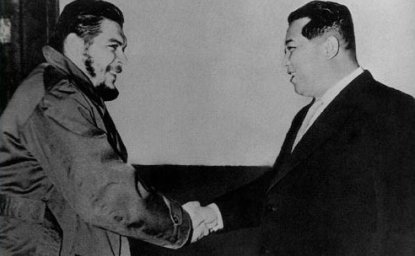Sino-DPRK Relations and Kim Il Sung’s Militant Strategy, 1965-1967





NKIDP e-Dossier no. 20
Whose War Plan Was It? Sino-DPRK Relations and Kim Il Sung’s Militant Strategy, 1965-1967
by Balázs Szalontai
April 2016
In October 2013, Chinese scholar Cheng Xiaohe presented a paper at an academic seminar hosted by the Institute for Peace Affairs, Seoul, in which he stated, on the basis of a declassified report written by Chinese Ambassador to Pyongyang Hao Deqing, that in 1965, Kim Il Sung asked China to send troops in preparation for a second Korean War. Cheng stressed that Kim expressed his intention to start a war, which, in his view, was both inevitable and necessary for unification.[1]
At first sight, Cheng’s narrative, which shows Pyongyang as the sole actor bent on provoking a new war, appears to be at least partially confirmed by a new set of Chinese documents obtained, translated, and published by the Wilson Center’s History and Public Policy Program. In October 1965, Kim did tell a Chinese delegation that “if war breaks out in Korea in the future, we would still need your help and would want to fight together…It seems war is inevitable, and it will come.” Similarly, in December 1965 Kim told Li Xiannian that “if something happens, [China and North Korea] must fight side-by-side.”
If, however, one examines the Hungarian document introduced here and published below, a different narrative emerges. In April-May 1965—that is, half a year before Kim’s conversations quoted above—several Soviet bloc diplomats in Pyongyang reported that Hao Deqing had straightforwardly informed them about a joint war plan as follows:
“China and the DPRK had reached an agreement that at a suitable time, and after the creation of a suitable pretext, they would start military operations against the American occupying forces along the demarcation line in Panmunjeom.”
In this narrative, the purported invasion plan was placed within the context of a Chinese-inspired continent-wide offensive, rather than presented solely as a North Korean initiative.
In 1966, yet another narrative surfaced, which cast China as the prime aggressor. A Central Intelligence Agency (CIA) report stated that from January 1966, the Chinese urged Pyongyang “to open a second front along the DMZ [Demilitarized Zone] and to begin guerrilla warfare on a large scale in the South in order to relieve pressure on Communist forces in Vietnam. This challenge was reported by various sources, first by the Yugoslavs in Moscow in January 1966, and subsequently by the Czechs in the Neutral Nations Supervisory Commission in Korea…Kim and his aides reportedly refused to comply.”[2] In the fall of 1966, Kim Il Sung did tell the Romanian ambassador that “China repeatedly tried to dissuade the DPRK from pursuing economic construction, for, according to the Chinese evaluation, the USA would soon launch a new war in Korea, in which case everything would be destroyed anyway. Kim Il Sung remarked that they had rejected this Chinese conception.”[3]
To reconcile these conflicting narratives with each other, one must first examine the possible motivations behind Hao Deqing’s statements made to the Soviet bloc ambassadors. The skeptical Hungarian ambassador had good reason to doubt why “the Chinese ambassador would so ‘confidentially’ disclose such a state secret,” all the more so because Hao could take it for granted that the East European diplomats, accustomed to pooling information, would notify the Soviets as well. Therefore, it does appear logical to regard Hao’s claims as an effort to manipulate, rather than simply inform, the pro-Soviet diplomats.
Judging from Hao’s extensive references to Vietnam, his statements should also be placed within the context of the signals Beijing sent to the US in April-June 1965 to dissuade Washington from escalating the Vietnam War to an extent that would threaten China’s security. The narrative offered by the East German ambassador (“an all-out military operation would take place [only] if American aggression directly affected China”) was particularly similar to the last point of Zhou Enlai’s “four-sentence warning”: “If the United States attacks China, war will have no limits.” Hao’s words on the discontinuation of economic construction probably referred to China’s Third-Front Defense program, and, hence, to Zhou’s Point 3 (“China is prepared”), while his claim about a Sino-DPRK war plan may be linked to the reference Zhou made to the lessons of the Korean War in Point 2. Prone to accuse Moscow of colluding with Washington over Vietnam, the Chinese possibly expected the Soviet bloc diplomats to forward their warnings to the United States, and thus convince the latter of China’s willingness to make America and its allies “really suffer.”[4]
At the same time, Hao made no reference to the very first point of Zhou’s “four-sentence warning” (“China does not want to provoke war against the United States”) but presented the purported continent-wide offensive as a surprise attack. Indeed, his claim about a premeditated Sino-DPRK invasion was quite at odds with the strategic thinking of the top Chinese leadership at the time, in which the prospect of a new Korean War loomed only as a worst-case scenario “that would definitely mean a U.S.-Chinese confrontation on PRC soil.”[5] Thus it seems possible that Hao’s statement on a Sino-North Korean agreement to attack South Korea was also aimed at sowing distrust between Pyongyang and the pro-Soviet diplomats (who were known for their opposition to Kim’s post-1962 belligerence toward Seoul), and thus hindering the process of Soviet-DPRK reconciliation that had started with Alexei Kosygin’s visit in February 1965. Notably, the North Koreans, aware of China’s disapproval, sought to downplay the significance of Kosygin’s visit in their conversations with Chinese diplomats.
Hao’s statements seem to have influenced Pyongyang’s conduct in several ways. On the one hand, the North Koreans tried to alleviate Soviet suspicions by stressing that their military preparations were of a purely defensive nature. In mid-1965, a Foreign Ministry official named Seong Myeong-se told a Hungarian diplomat that “the representatives of certain Afro-Asian countries encouraged them to wage armed struggle against the American imperialists who keep South Korea under occupation, but the Korean side disapproves and rejects this standpoint.”[6] On the other hand, Kim Il Sung’s allusions to Sino-DPRK cooperation in a new war may have been partly aimed at sounding out the seriousness of China’s belligerent claims and the extent of its military commitment to Pyongyang. Judging from Kim’s October 28 talk with a Chinese delegation, Kim still adopted a cautious approach: “we are currently not prepared to expand our struggle against South Korea. Unless we are certain that we can do it correctly, we are not prepared to provoke things.”
Whether China had originally encouraged the DPRK to pursue a confrontational policy or not, in 1966 Kim skillfully took advantage of Beijing’s belligerent statements to depict China as the prime aggressor, and thus conceal his own growing militancy from the USSR. Probably this is why the Kremlin evaluated the party conference of October 1966—which led to a sharp increase in military expenditures, and was soon followed by commando raids—in a surprisingly favorable way. In the view of the Soviets, the North Koreans “disassociated themselves from the Chinese standpoint that stressed the necessity of launching a guerrilla war in South Korea.” [7]
In 1967, the North Koreans took a different tact. During the DMZ clashes in October-November, they treated the Chinese delegation in the Military Armistice Commission with great outward courtesy. The press commemorated China’s entry into the Korean War, stressing Sino-Korean cooperation against imperialism.[8] Judging from these gestures, the Chinese chargé d’affaires was probably right when he told a Romanian diplomat in mid-1967 that “the Korean leadership…wants to create the impression that China also stands behind them.”[9] In reality, the peak of Kim’s militant strategy strongly coincided with the nadir of Sino-DPRK relations (January 1967-May 1969), and Pyongyang’s most provocative acts were closely followed by particularly virulent manifestations of Chinese hostility. While these coincidences do not necessarily indicate causality, it can be safely concluded that Kim’s militancy did not bring about a Sino-DPRK rapprochement, either because it was insufficient to mollify Chinese dissatisfaction with Soviet-North Korean cooperation, or because it could potentially draw China into a new war, or for both reasons.
All in all, it seems that the three narratives presented above were not ipso facto mutually exclusive. Each of them focused on a particular episode of Sino-DPRK relations, removing it from the surrounding context and thus obscuring the complexity of a partnership in which both sides used sophisticated techniques of manipulation, not only toward each other but also toward the Soviet bloc. For this reason, the question of Kim Il Sung’s 1965 request for Chinese troops needs further investigation, preferably by using multi-archival sources.
Balazs Szalontai is currently an assistant professor at Korea University, Sejong Campus, Department of North Korean Studies.
Suggested Citation: Balazs Szalontai, "Whose War Plan Was It? Sino-DPRK Relations and Kim Il Sung’s Militant Strategy, 1965-1967," NKIDP e-Dossier no. 20 (April 2016), accessible at https://www.wilsoncenter.org/publication/sino-dprk-relations-and-kim-il-sungs-militant-strategy-1965-1967.
***
Hungarian Embassy in the DPRK, Report, 30 May 1965. Subject: On China’s war plans.
[Source: Hungarian National Archives (MOL), XIX-J-1-j China, 1965, 71. doboz, IV-40, 003661/RT/1965, translated by Balázs Szalontai, accessible at http://digitalarchive.wilsoncenter.org/document/121766. ]
Concerning my ciphered telegrams of April 24th and 26th, I report the following:
Romanian Ambassador M. Bodnăraş and GDR Ambassador H. Brie separately informed Comrade Moskovsky about what Chinese Ambassador Hao Deqing had told them with regard to the situation in Asia.
Speaking about the support to be provided to Vietnam, Hao Deqing declared that the Soviet Union was supplying obsolete anti-aircraft guns and machine guns to Vietnam. In addition, the Soviet government asked for China’s permission to establish a Soviet military base, at which at least four thousand Soviet military advisers would be stationed, in Kunming.
In the opinion of the Chinese ambassador, things were progressing well in Vietnam and Asia, too, but he pointed out that the struggle against American imperialism would not be decided by the situation in Vietnam. The American imperialists must be chased out from the whole of Indochina, and even from the whole of Asia; this is what they [the Chinese] are preparing for. According to the Chinese standpoint, this required an unexpected attack [launched] on a wide front, the Chinese ambassador said. One must start military operations [all over] from Indochina to Korea, by which we will dissipate the military force of the imperialists. The Chinese ambassador also declared that China and the DPRK had reached an agreement that at a suitable time, and after the creation of a suitable pretext, they would start military operations against the American occupying forces along the demarcation line in Panmunjeom.
The Chinese people had done their best to develop the national economy and to construct socialism, Hao Deqing said. Unfortunately, the development of the international situation hinders their work to build up the country, and they must discontinue their efforts; they must switch to armed struggle against imperialism, and they must eliminate imperialism.
Cuban Ambassador Vigoa also informed me about this Chinese plan (he was the one who raised the issue). Among others, he said that according to the information available to him, the Chinese government was making preparations for a large-scale surprise attack that would be extended from Korea to Malaysia. During Subandrio’s visit in China in January, they allegedly managed to reach an agreement that at a suitable time, Indonesia would also launch an attack on Malaysia. Comrade Vigoa’s conversation with Yi Hyo-sun indicates a similar tendency. Namely, said person stated in the presence of the [Cuban] ambassador that they (Korea) were ready to take action against the imperialist occupying forces, but for the time being, they were reluctant to [initiate] such an action, because due to the inter-party disagreements, there was no unity between the socialist countries. That is, they were not certain whether the fraternal countries would support such a military operation.
There is a small discrepancy between the narratives of the Romanian and GDR ambassadors. Comrade Bodnăraş claimed that the Chinese were making preparations for such an action, and they would [launch] it at their convenience, whereas according to Comrade Brie (who later corrected this statement, though), the Chinese ambassador expressed the view that an all-out military operation would take place [only] if American aggression directly affected China, too.
It is possible that the information provided by the Chinese ambassador serves purposes of disinformation, for it is doubtful if the Chinese ambassador would so “confidentially” disclose such a state secret. Nevertheless, one cannot know for sure if they are actually contemplating such a plan or not.
According to the information that I obtained from Comrade Polish Ambassador Naperaj in the recent days, the Korean comrades are in the process of concentrating troops near the demarcation line. Lately, they have not granted permission to the [members of the] Polish section of the Neutral Nations Supervisory Commission to hunt in the vicinity of the demarcation line in Panmunjeom.
On the occasion of my trip to Panmunjeom on May 12-14th, I also noticed the construction of new anti-tank obstacles in the northern part of the demilitarized zone. True, in the opinion of Comrade Colonel Borski, the stones, whose diameter is approximately 50-60 centimeters and which have been placed on the soft soil that was tilled as late as last year, can hardly be regarded as effective anti-tank obstacles. Nevertheless, this is the first occasion since 1953 that such [obstacles] are being constructed along the highway.
Finally, one may raise the question (which we discussed with the Polish ambassador) of whether the Chinese obstruction of Soviet arms shipments to Vietnam could be related to the aforesaid Chinese plan.
József Kovács
(ambassador)
[1] “N. Korea asked China for troops in 1965 in preparation for 2nd Korean War: Chinese scholar,” Yonhap News Agency, October 24, 2013, http://english.yonhapnews.co.kr/northkorea/2013/10/24/64/0401000000AEN20131024002800315F.html.
[2] CIA Intelligence Report, “Kim Il-Sung’s New Military Adventurism,” November 26, 1968, CIA Electronic Reading Room (CERR) (accessed at http://www.foia.cia.gov ).
[3] “Report, Embassy of Hungary in the DPRK to the Hungarian Foreign Ministry,” November 18, 1966, Hungarian National Archives (Magyar Országos Levéltár, MOL), XIX-J-1-j Korea, 1966, 74. doboz, IV-250, 005007/3/1966.
[4] James G. Hershberg and Chen Jian, “Reading and Warning the Likely Enemy: China’s Signals to the United States about Vietnam in 1965,” The International History Review 27, no. 1 (March 2005): 47-84; Lorenz M. Lüthi, “Reading and Warning the Likely Enemy – a Commentary: Signalling Across Four Continents,” The International History Review 35, no. 4 (August 2013): 807-816. The Third-Line Defense program was aimed at relocating vital economic enterprises to China’s interior so as to make them less vulnerable to possible U.S. air raids.
[5] Lorenz Lüthi, “The Vietnam War and China’s Third-Line Defense Planning before the Cultural Revolution, 1964-1966,” Journal of Cold War Studies 10, no. 1 (Winter 2008): 39.
[6] “Report, Embassy of Hungary in the DPRK to the Hungarian Foreign Ministry,” July 7, 1965, MOL, XIX-J-1-j Korea, 1965, 73. doboz, IV-14, 00465/5/1965.
[7] Balázs Szalontai, “In the Shadow of Vietnam: A New Look at North Korea’s Militant Strategy, 1962-1970.” Journal of Cold War Studies 14, no. 4 (Fall 2012): 157.
[8] “Report, Embassy of Hungary in the DPRK to the Hungarian Foreign Ministry,” November 17, 1967, MOL, XIX-J-1-j Korea, 1967, 61. doboz, 1, 001200/1/1967.
[9] “Report, Embassy of Hungary in the DPRK to the Hungarian Foreign Ministry,” July 24, 1967, MOL, XIX-J-1-j Korea, 1967, 60. doboz, 103, 003509/1967.
Author

Associate Professor of North Korean Studies at Korea University, Sejong Campus, Republic of Korea.

North Korea International Documentation Project
The North Korea International Documentation Project serves as an informational clearinghouse on North Korea for the scholarly and policymaking communities, disseminating documents on the DPRK from its former communist allies that provide valuable insight into the actions and nature of the North Korean state. Read more


History and Public Policy Program
A leader in making key foreign policy records accessible and fostering informed scholarship, analysis, and discussion on international affairs, past and present. Read more


Cold War International History Project
The Cold War International History Project supports the full and prompt release of historical materials by governments on all sides of the Cold War. Read more


Hyundai Motor-Korea Foundation Center for Korean History and Public Policy
The Center for Korean History and Public Policy was established in 2015 with the generous support of the Hyundai Motor Company and the Korea Foundation to provide a coherent, long-term platform for improving historical understanding of Korea and informing the public policy debate on the Korean peninsula in the United States and beyond. Read more

Explore More
Browse Insights & Analysis
Zhou Enlai and China's Response to the Korean War

China and the Post-War Reconstruction of North Korea, 1953-1961

